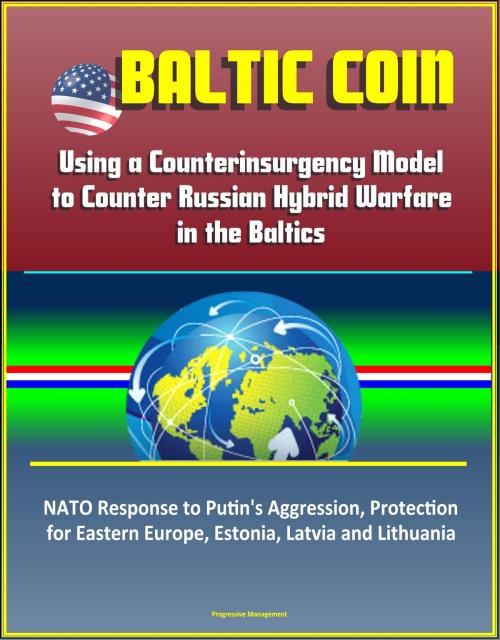Baltic COIN: Using a Counterinsurgency Model to Counter Russian Hybrid Warfare in the Baltics - NATO Response to Putin's Aggression, Protection for Eastern Europe, Estonia, Latvia and Lithuania
Nonfiction, History, Eastern Europe, Asian, Russia| Author: | Progressive Management | ISBN: | 9781370566594 |
| Publisher: | Progressive Management | Publication: | March 25, 2017 |
| Imprint: | Smashwords Edition | Language: | English |
| Author: | Progressive Management |
| ISBN: | 9781370566594 |
| Publisher: | Progressive Management |
| Publication: | March 25, 2017 |
| Imprint: | Smashwords Edition |
| Language: | English |
This excellent report has been professionally converted for accurate flowing-text e-book format reproduction. EUCOM and NATO commanders today face a new threat in Eastern Europe in the form of Russian hybrid warfare, as recently seen in Crimea and the Ukraine. As EUCOM and NATO planners develop operational contingency plans for hybrid warfare in this theater, the tenets of counterinsurgency provide a logical framework for a successful operational design. This paper examines how commanders and their staffs can utilize battle proven COIN design tenets to counter the current Russian ideas of hybrid warfare. This paper also delves into the efficacy of Article V of the NATO charter and how it will affect the NATO timeline for response should Russia instigate hybrid war in the Baltics.
Over the course of the last decade, conflict in the EUCOM theater has shifted toward non-lethal forms of aggression that are being used in combination with traditional lethal military force, a combination that is increasingly labeled hybrid warfare. U.S. and NATO commanders today face a very real and significant threat that does not have a well established doctrinal response. Although hybrid warfare is not necessarily a form of insurgency, if EUCOM and NATO commanders act while the conflict is still in its non-lethal stages, they can effectively use the tools developed for counterinsurgency (COIN) to respond to early stage hybrid warfare, which may span the spectrum of non-lethal means from strategic communications, propaganda, cyber attack and engineered social unrest to special forces operations and the use of unmanned drones. For these responses to be effective, it is important that commanders recognize early stage hybrid warfare, and respond proportionately and appropriately before the conflict develops into a more traditional armed conflict. This is especially true in response to Russia's new methods of armed conflict, tested and refined in Georgia, Crimea and the Ukraine - a form of hybrid warfare that is causing concern to Eastern European NATO states who are unsure if western powers will be willing to act in collective defense to non-traditional forms of attack.
If Russia continues this pattern of aggression, EUCOM and NATO commanders can expect to see it reprised in the Baltic countries of Estonia, Latvia and Lithuania, all relatively recent additions to NATO that in the past fell within the Russian sphere of influence. In Russia's recent incursions into Crimea and the Ukraine, one of the primary factors that President Putin used to both enable and justify Russian aggression was the presence of a large ethnic Russian minority that he asserted were being repressed. Looking at NATO member nations in the Baltics, it is easy to see parallels in every country, as they all have sizable Russian minorities, but most notably the Estonian county of Ida-Viru, centered around the city of Narva, where ethnic Russians make up 70% of the population. As Ida-Viru shares a border with Russia, this north-east corner of Estonia is ripe for conflict and would be a logical bridge into the Baltics. Looking at this area of Estonia (and equally as strategically important and exploitable, the south-eastern provinces of Latvia with their high population density of ethnic Russians) can help NATO planners create specific, detailed plans for the next stage of hybrid warfare in Eastern Europe.
This excellent report has been professionally converted for accurate flowing-text e-book format reproduction. EUCOM and NATO commanders today face a new threat in Eastern Europe in the form of Russian hybrid warfare, as recently seen in Crimea and the Ukraine. As EUCOM and NATO planners develop operational contingency plans for hybrid warfare in this theater, the tenets of counterinsurgency provide a logical framework for a successful operational design. This paper examines how commanders and their staffs can utilize battle proven COIN design tenets to counter the current Russian ideas of hybrid warfare. This paper also delves into the efficacy of Article V of the NATO charter and how it will affect the NATO timeline for response should Russia instigate hybrid war in the Baltics.
Over the course of the last decade, conflict in the EUCOM theater has shifted toward non-lethal forms of aggression that are being used in combination with traditional lethal military force, a combination that is increasingly labeled hybrid warfare. U.S. and NATO commanders today face a very real and significant threat that does not have a well established doctrinal response. Although hybrid warfare is not necessarily a form of insurgency, if EUCOM and NATO commanders act while the conflict is still in its non-lethal stages, they can effectively use the tools developed for counterinsurgency (COIN) to respond to early stage hybrid warfare, which may span the spectrum of non-lethal means from strategic communications, propaganda, cyber attack and engineered social unrest to special forces operations and the use of unmanned drones. For these responses to be effective, it is important that commanders recognize early stage hybrid warfare, and respond proportionately and appropriately before the conflict develops into a more traditional armed conflict. This is especially true in response to Russia's new methods of armed conflict, tested and refined in Georgia, Crimea and the Ukraine - a form of hybrid warfare that is causing concern to Eastern European NATO states who are unsure if western powers will be willing to act in collective defense to non-traditional forms of attack.
If Russia continues this pattern of aggression, EUCOM and NATO commanders can expect to see it reprised in the Baltic countries of Estonia, Latvia and Lithuania, all relatively recent additions to NATO that in the past fell within the Russian sphere of influence. In Russia's recent incursions into Crimea and the Ukraine, one of the primary factors that President Putin used to both enable and justify Russian aggression was the presence of a large ethnic Russian minority that he asserted were being repressed. Looking at NATO member nations in the Baltics, it is easy to see parallels in every country, as they all have sizable Russian minorities, but most notably the Estonian county of Ida-Viru, centered around the city of Narva, where ethnic Russians make up 70% of the population. As Ida-Viru shares a border with Russia, this north-east corner of Estonia is ripe for conflict and would be a logical bridge into the Baltics. Looking at this area of Estonia (and equally as strategically important and exploitable, the south-eastern provinces of Latvia with their high population density of ethnic Russians) can help NATO planners create specific, detailed plans for the next stage of hybrid warfare in Eastern Europe.















